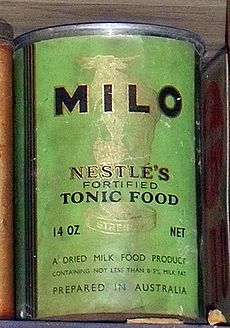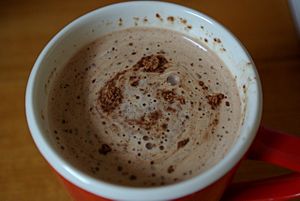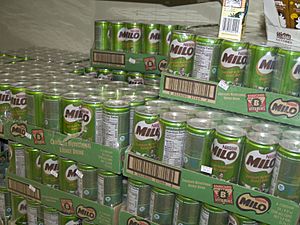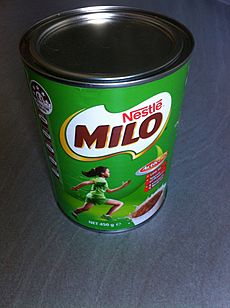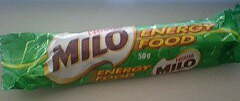Milo (drink) facts for kids
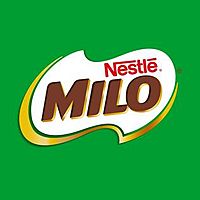
MILO's logo
|
|
| Type | Malted dairy milk |
|---|---|
| Owner | Nestlé |
| Country | Australia/New Zealand |
| Introduced | 1934 |
| Markets | Worldwide; most notably the regions of Oceania, South America, South-east Asia and certain parts of Africa |
| Tagline | MILO Everyday! |
Milo (also written as MILO) is a popular chocolate and malt powder. You mix it with hot water and milk to make a tasty drink! It's especially popular in places like Oceania, South America, South-east Asia, and parts of Africa.
Milo is made by a company called Nestlé. It was first created by an inventor named Thomas Mayne in Sydney, Australia in 1934. Today, you can find Milo sold in many countries around the world.
Milo usually comes as a powder in a green tin. These tins often show pictures of people playing different sports. In some countries, you can also buy Milo as a ready-to-drink beverage. It has even been made into snack bars and breakfast cereals! The way Milo tastes and what it's made of can be a little different depending on the country.
Milo is super popular in many places, including Malaysia, Philippines, Indonesia, Colombia, Peru, and parts of Central and West Africa.
Contents
How Milo is Made
Milo is made by taking a thick, syrupy liquid and removing the water from it. This syrup comes from malted (which means specially treated) wheat or barley. These ingredients are sourced from other companies.
In 2016, Nestlé Philippines announced they would start making Milo with a new recipe called "protomalt." This protomalt is made from carbohydrates (energy-giving nutrients) that come from barley and cassava.
Milo's History
In 1934, an Australian chemist and inventor named Thomas Mayne created Milo. He first showed it to the public at the Sydney Royal Easter Show, a big event in Australia.
Milo started being made at a factory in Smithtown, which is near Kempsey in New South Wales. The name "Milo" comes from a famous ancient Greek athlete called Milo of Croton. He was known for his incredible strength, which is why the drink was named after him!
How People Enjoy Milo
People enjoy Milo in many different ways! Sometimes, they sprinkle the powder on top of ice cream or breakfast cereals. Milo is also often used for the "Tim Tam Slam", where you use a Tim Tam biscuit as a straw to drink Milo!
Milo made outside Australia is often changed to fit how people in those countries like to prepare it. In Malaysia, Singapore, Brunei, and some other parts of Asia, Milo with ice is called "Milo Ice" (or "ping" or "peng," which means ice in some Chinese languages). You can even find iced Milo at fast-food places like KFC and McDonald's!
In local coffee shops (called kopitiams) and food stalls (called mamak stalls), you can find special Milo drinks. These include "Milo Dinosaur" (a cup of Milo with an extra spoonful of undissolved Milo powder on top) and "Milo Godzilla" (Milo with ice cream or whipped cream). There's also "Neslo," which is Milo mixed with Nescafé coffee powder. Milo powder is also used to make a popular dessert called Batik cake. In Hong Kong, Milo is served in traditional tea restaurants called Cha chaan teng.
Milo is also a famous drink at Indian Muslim food stalls, known as Mamak stalls, in Malaysia. Sometimes, it's even used as a spread on bread, like jam, or as an ingredient in a type of flatbread called Roti Canai. This is often called "Roti Milo."
Milo Marketing
In Australia and most other countries, Milo packaging is green and shows people playing various sports. This is because Milo is often promoted as an energy drink for active people. There used to be a version with more malt in a brown tin, but it's not made anymore. There's also an organization called MILO in2CRICKET, where volunteers teach kids how to play cricket.
Milo's commercials often use the catchy slogan "Go and go and go with Milo." Another slogan used is "I need my Milo Today." In Malaysia and Singapore, the green tin with sports pictures led to Milo being nicknamed "Tak Kiu," which means "football" in a Chinese language called Hokkien. In Colombia, Milo is very connected to football, and their slogan is Milo te da energía, la meta la pones tú ("Milo gives you the energy, you set the goal").
Milo is incredibly popular in Malaysia and Singapore. It has a huge share of the market there, and Malaysians are said to be the biggest consumers of Milo in the world! This is partly because when Milo was first introduced, it was seen as a healthy nutrient supplement. So, it became known as a "must-have" drink for everyone. Milo made in Malaysia is designed to dissolve easily in hot water for a smooth hot chocolate drink, or with ice for a cold one. "Milo Vans" are often seen at school sports days in these countries, where kids line up to get free cups of Milo.
In Peru, during the 1970s, Milo labels used to show pictures of Peruvian towns, history, crops, and animals. This was meant to be educational. But after 1980, sports pictures became common on the labels again.
Nestlé has also brought a Canadian version of Milo to the market. It dissolves quickly, like Nesquik, and still has that malt flavor. It's also a bit sweeter than other versions. Milo has been in Eastern Canada since the late 1970s, brought by people from places like the Caribbean and Hong Kong. It was first sold in small ethnic grocery stores but is now available in larger supermarkets. Some Asian supermarkets might also sell versions imported from China or Hong Kong.
Nestlé doesn't widely market Milo in the United States, except in international sections of some grocery stores. However, since 2017, Milo made in Colombia has started appearing in supermarkets like Walmart (in Hispanic sections) and King Soopers.
You can also find Milo in the United Kingdom in some Sainsbury's and Tesco supermarkets. These stores often import it from Kenya and South Africa. Asian food stores also sell it. A similar product called Ovaltine is more popular with UK consumers.
In Ireland, Milo can be found in many Asian or African stores, usually the Kenyan or Filipino versions.
In China, Milo is commonly sold in Western supermarkets and smaller convenience stores. It often comes in a flexible foil pouch, and you can also buy single-drink packets. The Milo in China has more milk solids, so you don't always need to add extra milk.
Milo used to be available in Portugal and Brazil. Nestlé Brazil stopped making Milo to focus on other popular local brands like Nescau and Nesquik. However, the Chilean version of Milo is still made and tastes just like the one that was once produced in Brazil. In May 2013, after more than 20 years, Nestlé brought Milo back to the Portuguese market.
Milo's Nutrition
Milo powder contains energy, mostly from carbohydrates (sugars). This is why Milo is often marketed as an energy drink. The New Zealand version of Milo is about 46 percent sugar.
Milo mixed with water has a Glycemic Index (GI) of 55. The GI tells you how quickly a food raises your blood sugar. For comparison, milk has a much lower GI of 30-33. So, if you mix a small amount of Milo into a mug of milk, the overall GI will be closer to milk's lower number.
The Milo website says that the drink is high in important nutrients like calcium, iron, and B vitamins (B1, B2, B6, B12). Milo is advertised as having "Actigen-E," which is just Nestlé's special name for the vitamins in the Milo recipe.
Milo also contains a small amount of theobromine. This is a natural substance found in cocoa, similar to caffeine.
Other Milo Products
Milo is available as a snack in a cube shape in countries like Nigeria, Ghana, and Dubai.
In Australia, a new version of Milo called Milo B-Smart was released in 2008. It has a finer texture and added B vitamins and iodine. It tastes different from the original Milo and is sold as a healthy food for children.
Images for kids
See also
 In Spanish: Milo (bebida) para niños
In Spanish: Milo (bebida) para niños



